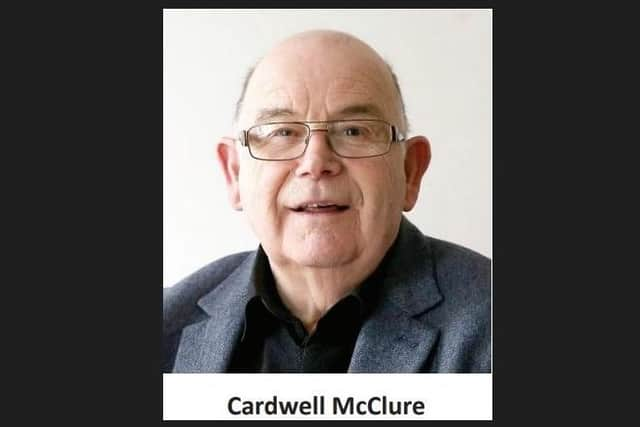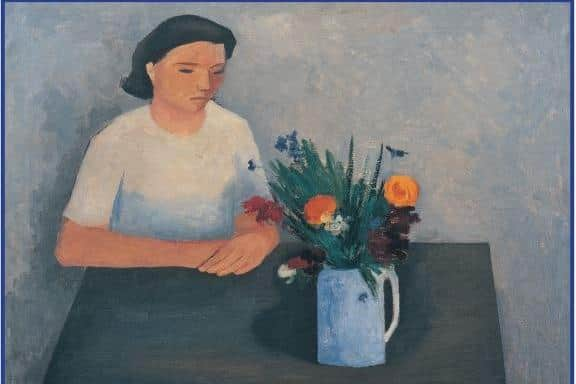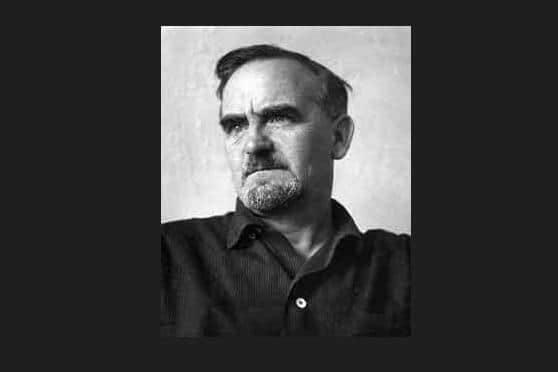Portadown author Cardwell McClure pens epic book on famous uncle William Scott - one of David Bowie's favourite artists
and live on Freeview channel 276
The nephew of acclaimed Fermanagh artist William Scott, who was a favourite of rock star David Bowie, has completed a decade-long labour of love by publishing a remarkable book about the colourful life of his uncle, one of whose paintings has sold for over a million pounds.
-


-
Cardwell McClure, a nephew who lives in Portadown overcame serious illness – and Covid – to finish his 262-page book which also records the fascinating stories of other members of William Scott’s family including an Oscar-winning movie director who is the artist’s son.
Advertisement
Hide AdAdvertisement
Hide AdScott who died at his home near Bath in 1989 at the age of 76 after living with Alzheimer’s for several years, is recognised as one of the UK’s foremost painters and his work can be found in public collections around the world including the Tate, the Guggenheim and the Metropolitan and nearer home in the Fermanagh County Museum as well as in the Ulster Museum in Belfast.
A section of Cardwell McClure’s lavishly-illustrated book, William Scott: A Family History deals with the Bowie connection. It says in 1993 Bowie bought a 1938 figurative Scott painting called ‘Girl Seated at Table’ for £45,000 four times its estimated auction price. Bowie said he purchased it ‘because I liked it.’ After Bowie’s death in 2016 it sold at Sotheby’s for £337,000 and it was used to illustrate newspaper and magazine articles about the musician’s extensive – and expensive - collection which realised a staggering £24 million at auction. ‘Still Life No 2” a painting by Scott from 1956 which was also in Bowie’s collection sold at Sotheby’s for over £300,000.


The record for a Scott painting at auction is £1,071,650 which was paid in 2008 at Christie’s for a work called ‘Bowl, Egg and Lemons’ which has an unfinished painting of the artist’s son Robert on the reverse.
Cardwell says: “He painted barbers’ signs, shop signs and anything else that needed to be done in the workshop prior to them being fitted by his father. His father was hungry for work and took on anything including painting and touching up Orange Order banners. Young William assisted him with these.”
Advertisement
Hide AdAdvertisement
Hide AdCardwell’s book doesn’t flinch from recalling the poverty, the tragedy and the war traumas which bedevilled the family. Cardwell’s grandmother Agnes Scott, the artist’s mother, was predeceased by no fewer than five of her 11 children as well as by her first husband who died trying to save a woman and her child from a fire in Enniskillen.
The author of the book, who took his name from Agnes’ second husband William Hobson Cardwell, has devoted a chapter to each of the Scott children. The main one focuses on William Scott whose talents, according to Cardwell, were recognised early in life with his skills honed by renowned locally-based artist Kathleen Bridle who took him under her wing at art classes in Enniskillen. But after tragedy struck on November 4, 1927 when William’s father fell from a ladder and died as he tried to put out a fire in a shop in Church Street Agnes Scott was left penniless.


However William Copeland Trimble, the proprietor of the Impartial Reporter newspaper in Enniskillen helped set up a fund which collected £700 to send young William to study at Belfast College of Art in 1928. In 1931, William got a scholarship to the Royal Academy Schools in London where he initially enrolled in a sculpture course but later switched to painting.
One of his friends at the Royal Academy was the Welsh poet Dylan Thomas with whom he shared a flat. Scott’s work quickly captured the attention of art lovers but no-one could have foreseen just how major a figure he would become over six decades in Britain where he settled. Cardwell says it wasn’t until the 1950s when his mother Mary showed him a Who’s Who entry for her brother that he appreciated just how influential an artist his uncle was.
It’s been conservatively estimated that he painted over 1,000 oils during his illustrious career and his work has reached consistently high prices in recent years with Bowie’s patronage increasing interest in him even more. William’s two sons Robert and James set up a Foundation in his memory in 2007 with the aim of preserving an archive of their father’s work and of supporting the Alzheimer’s Society.
James made a film in 1984 for Channel 4 called “Every Picture Tells a Story” which is about his father’s early life. Two years earlier James had crowned a glittering film career by winning an Oscar for a short movie, “A Shocking Accident” an adaption of a Graham Greene story, starring Rupert Everett and Jenny Seagrove. However Cardwell says James stepped back from the film industry after ‘the devastating experience’ of working with American movie mogul Harvey Weinstein, who was later convicted of sex offences against women. James, who’s based in America, has built a hugely regarded career in the art world. His elder brother Robert studied sculpture in Milan under an award winning sculptor; picked up an Italian drawing prize; studied interior architecture under the tutelage of Sir Hugh Casson; became a director of a firm setting up international exhibitions and later still turned his hand to graphic design. His company adapted one of William Scott’s paintings, Berlin Blues 2, for use on a 5p stamp issued by the Irish Post Office in 1973.
Cardwell says he was inspired to write his family record after the curator of the Fermanagh County Museum Sarah McHugh and her staff told him during a visit there ten years ago that while they had a lot of information about William Scott they had little or no knowledge of his brothers and sisters who had been brought up in the town. Cardwell agreed to find out more and during his three years of research he travelled far and wide in Ireland and Scotland to establish more about his uncles and aunts. And by a stroke of good fortune, he was able to access photographs, cuttings and files which his mother Mary had kept.
“I didn’t come across some of them until we were clearing out the house after her death so I’m pleased to acknowledge that my mum played a huge part in the compiling of the book about her family,” says Cardwell who knew more about William Scott’s artistic prowess than he did about the man. “I only met him twice,” he says. “Once was in 1951 when he was home for a funeral of a brother who had been killed in an accident in New Zealand and the other time was in 1981 during a visit to my mother and father.
“I took them all out for a meal in Portadown and I heard William reminiscing with my mother about the times he asked her to sit for him for his paintings. She was his first female sitter as such. At one point William invited me to visit him and his family in England and told me to bring a suitcase full of money because he would sell me any of his paintings for a thousand pounds – in cash! However I never took him up on his offer despite my father encouraging me to do so. I’ve had a look at the value of his paintings from that era and I reckon they’d be worth around £40.000 today. So I missed a chance.”
Cardwell who had to put his book on hold after his health deteriorated in 2016 before Covid-19 presented even more challenges says: “The editor of the book Paul Teggart encouraged me to push ahead with it and with his help I was able to get it completed and off to the publisher.”
Advertisement
Hide AdAdvertisement
Hide AdCardwell who has written a number of other books including the histories of Portadown Gasworks, the town’s Foundry and the Edenderry area of Portadown. Sadly Paul, a former schoolteacher from Richhill, passed away in January 2023 before he got the opportunity to see the finished book.
Says Cardwell who has also produced a separate booklet outlining the Scott family tree says: “I think there’s a lot to be proud of in the new book. I believe I have been able to find out everything about the family that’s possible. And the response from people and institutions who’ve had a glimpse of the book has been extremely positive.”
Interesting asides in the book include the controversy that erupted over William Scott’s 46 foot long mural at Altnagelvin Hospital in Londonderry in 1962 when newspaper reports said the reaction from people attending the unveiling was one of ‘horrified silence.’ And there are also references to a Royal interest in William Scott’s work visited a gallery and studio set up to honour Scott’s friend, the internationally renowned sculptor F.E. McWlliam near Banbridge. A BBC report from the time said that Scott’s paintings which were being exhibited ‘caught the eye’ of the monarch and her husband.
The book, William Scott: A Family History is available from Amazon and more details about it and the Scott Family Tree booklet can be obtained via email from cardwell.mcclure@btopenworld.com.
